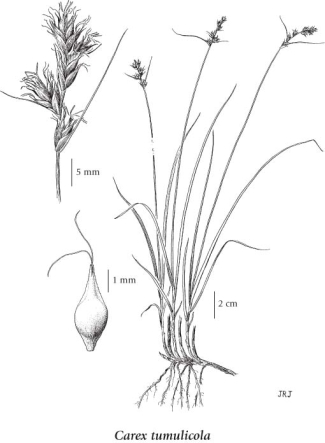Carex tumulicola Mack.
foothill sedge (splitawn sedge)
Cyperaceae (Sedge family)
Introduction to Vascular Plants
foothill sedge (splitawn sedge)
Cyperaceae (Sedge family)
Introduction to Vascular Plants
Species Information
General:
Perennial, loosely tufted herb from elongated, fibrous rhizomes; stems 30-80 cm tall, arising in circular clusters with less dense centres, roughened on the angles above, longer than the leaves.
Leaves:
Sheaths tight; blades 2 to 3 per stem, borne on the lower 1/4 of the stem, flat or channeled below, 1.5-2 mm wide, reduced to scales at the base of the stem.
Flowers:
Spikes 4 to 8, the upper ones rising close together, the lower ones noticeably remote, unstalked, with both female and male flowers, the inconspicuous male flowers towards the tips, female flowers at the bases; bracts awnlike, the lowermost conspicuous, slightly shorter to longer than the inflorescence.
Fruits:
Perigynia egg-shaped or elliptical, 3.6-5 mm long, 1.8-2.2 mm wide, with faint inconspicuous nerves, green, smooth, very short-stalked, finely toothed on the upper halves, the beaks 1/3 the length of the bodies, bidentate; female scales egg-shaped, equalling or slightly shorter than the perigynia, pointed or short-awned, brown, the midribs greenish, the margins translucent; stigmas 2; achenes lens-shaped, smooth, 1.8-2.2 mm long, filling the bodies of the perigynia.
Illustration

If more than one illustration is available for a species (e.g., separate illustrations were provided for two subspecies) then links to the separate images will be provided below. Note that individual subspecies or varietal illustrations are not always available.
Illustration Source: The Illustrated Flora of British Columbia
Habitat and Range
Mesic Garry oak stands and dry, grassy meadows and rock outcrops in the lowland zone; rare in SW BC, known only from southern Vancouver Island; S to CA.Status Information
| Origin Status | Provincial Status | BC List (Red Blue List) | COSEWIC |
|---|---|---|---|
| Native | S3S4 | Yellow | E (Mar 2008) |
BC Ministry of Environment: BC Species and Ecosystems Explorer.
Similar Species
Carex hoodii has spikes that are more tightly clustered and which lack a large bract that surpasses the lower spikes. Similarly, Carex vallicola does not have large subtending bracts that are longer than the lower flower spikes. In addition, C. vallicola does not exceed 40 cm in height and has pale scales, usually shorter than the perigynia (Miller et al. 2005). Carex tumulicola and C. vallicola, however, do not co-occur in B.C.
Source: British Columbia Conservation Data Centre |